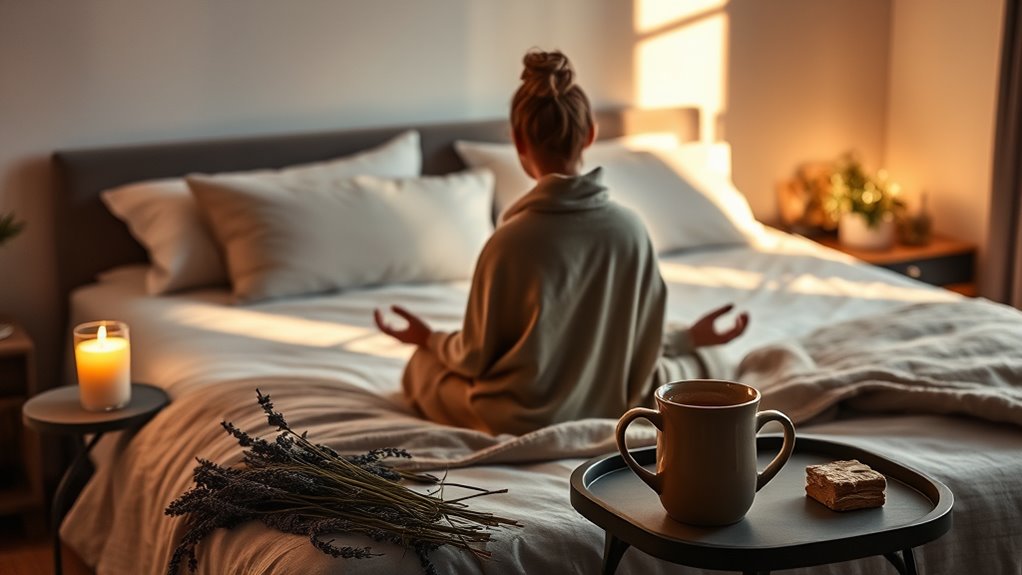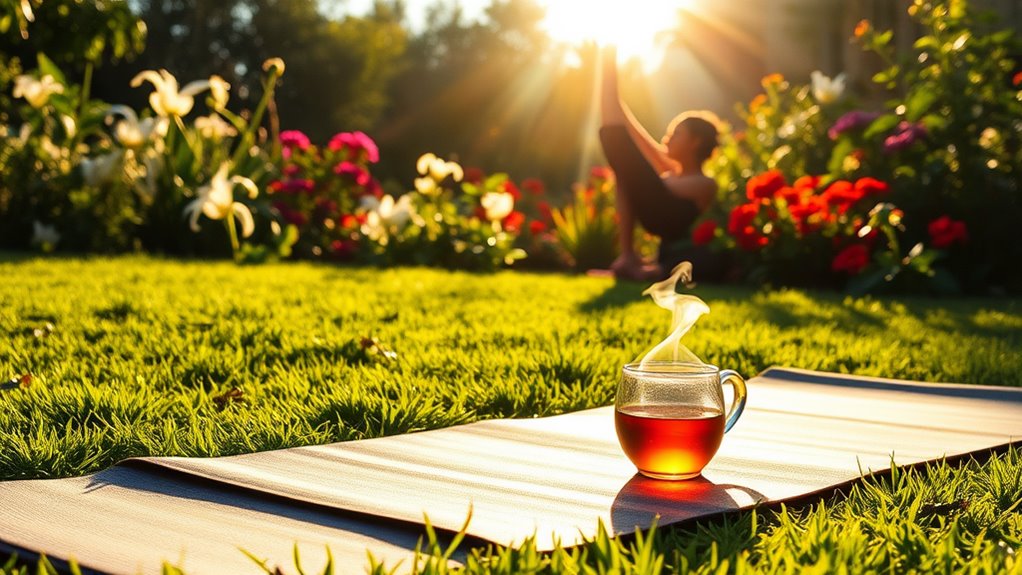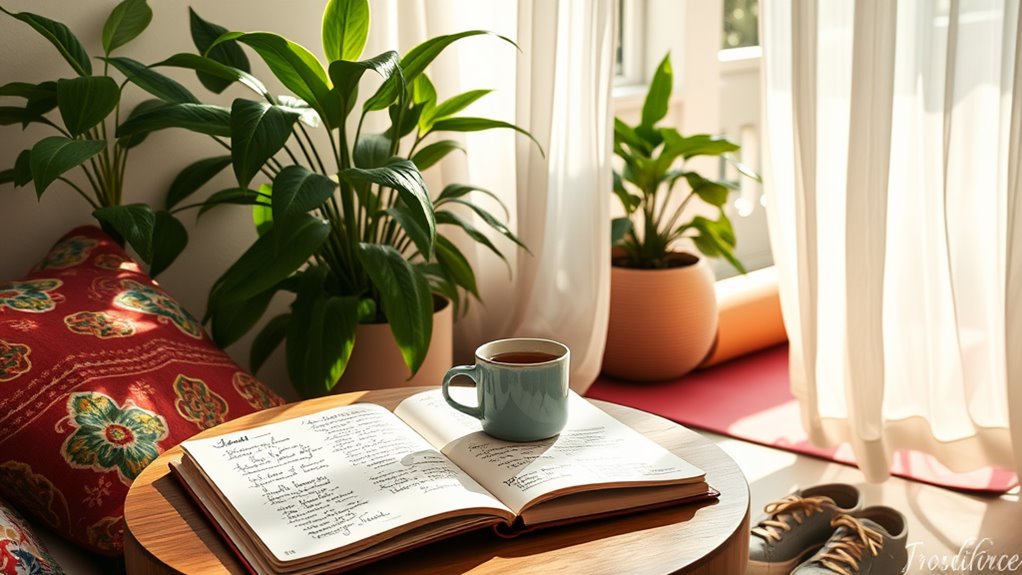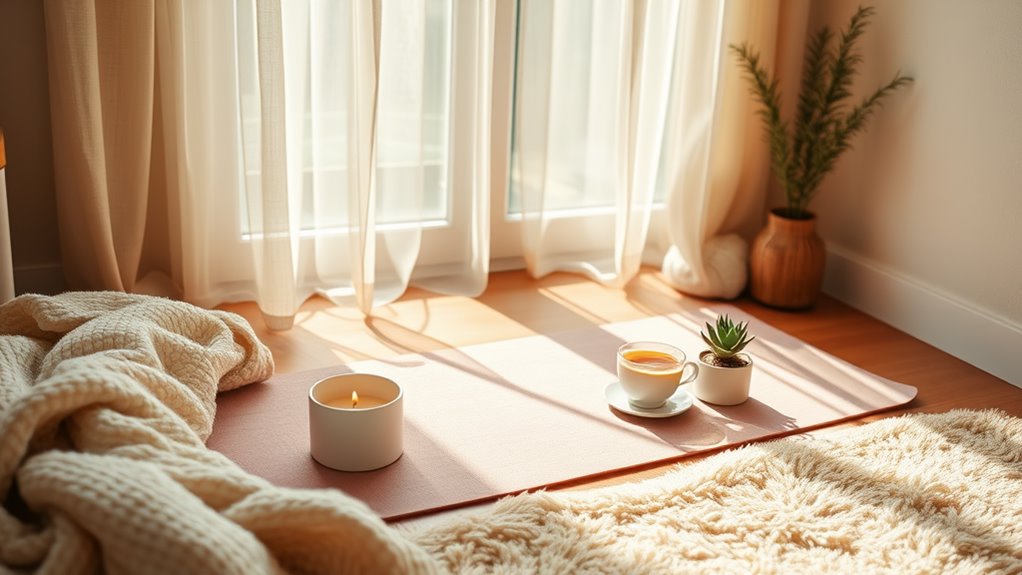These Relaxation Techniques Will Help You Fall Asleep Faster
If you want to fall asleep faster, try deep breathing exercises and progressive muscle relaxation to calm your mind and body. Guided imagery can transport you to a serene place, while mindfulness meditation helps quiet racing thoughts. Incorporate gentle yoga poses into your evening routine, and consider using aromatherapy to enhance relaxation. Establishing a consistent bedtime routine and limiting screen time also play essential roles. Keep exploring these techniques for even more restful nights ahead!
Key Takeaways
- Practice deep breathing exercises to calm your mind and body, promoting relaxation and grounding in the present moment.
- Incorporate progressive muscle relaxation to relieve tension by tensing and relaxing each muscle group in your body.
- Utilize guided imagery techniques to create serene mental spaces that ease worries and enhance your relaxation.
- Establish a consistent bedtime routine, including dimming lights and engaging in calming activities to signal your body to wind down.
- Limit screen time an hour before bed to avoid disrupting your natural sleep-wake cycles, promoting better sleep quality.
Deep Breathing Exercises
Deep breathing exercises can be a powerful tool to help you unwind and prepare for restful sleep. By focusing on your breath, you initiate a process that promotes body and mind relaxation.
Start by inhaling deeply through your nose, allowing your abdomen to expand. Hold that breath momentarily, then release it slowly through your mouth. Repeat this pattern, aiming for a steady rhythm. Each breath breaks the cycle of racing thoughts, grounding you in the present moment.
As you practice, visualize the tension melting away from your body. Let each exhale carry stress and worry into the air, creating space for tranquility. Engaging in these practices can complement your routine and enhance your overall well-being through mindfulness and relaxation techniques.
Make deep breathing a nightly ritual, and you’ll cultivate a serene environment to soothe your mind and lull you into sleep.
Progressive Muscle Relaxation
As you settle in for the night, Progressive Muscle Relaxation (PMR) can guide you toward a deeper sense of calm.
Begin by finding a comfortable position, closing your eyes, and taking a slow, deep breath. Tense the muscles in your feet for five seconds, then release while exhaling.
Move gradually up your body—calves, thighs, abdomen, arms, shoulders, and face—tensing and relaxing each muscle group. Focus on the difference between tension and relaxation; let go of the stress you carry.
This method not only reduces muscle tension but also quiets your mind. In fact, establishing a relaxing bedtime routine can significantly enhance your sleep quality. Practice PMR regularly, and you’ll master a powerful technique to help you unwind, paving the way for restful sleep each night.
Guided Imagery Techniques
While you settle into bed, guided imagery techniques can transport you to a serene mental space, easing the day’s worries.
By harnessing the power of your imagination, you can create vivid mental images that promote relaxation and tranquility.
Here are three techniques to ponder:
-
Nature Visualization: Picture yourself in a peaceful forest, complete with gentle streams and rustling leaves. Let the calming sounds envelop you.
-
Safe Haven Imagery: Create a personal retreat in your mind—a cozy cabin or a sunlit beach—where you feel completely secure and relaxed.
-
Storytelling Technique: Imagine a story unfolding where you’re the protagonist in a calming adventure, letting each detail draw you deeper into relaxation.
These techniques can foster a soothing environment that enhances your sleep quality. Additionally, incorporating soothing breathing exercises can further promote relaxation and readiness for sleep.
Meditation for Better Sleep
Meditation can be a powerful tool to enhance your sleep quality.
By practicing mindfulness meditation, incorporating guided techniques, and using breathing exercises, you’ll find it easier to unwind at the end of the day. Additionally, harnessing breath through focused breathing practices can significantly promote relaxation and mental clarity, making it easier to fall asleep peacefully.
Let’s explore how these methods can help you achieve a more restful night.
Mindfulness Meditation Benefits
When you incorporate mindfulness meditation into your nightly routine, you can greatly enhance your sleep quality. This practice helps quiet your mind, allowing you to drift into a more restful state.
Here are three key benefits of mindfulness meditation for sleep:
-
Reduces Stress: By focusing on your breath and being present, you lower cortisol levels, making it easier to relax.
-
Improves Focus: As you practice being mindful, you sharpen your attention skills, helping you let go of distractions that can keep you awake.
-
Facilitates Deeper Sleep: Regular mindfulness practice trains your brain to enter deeper sleep stages, increasing restorative processes and enhancing overall sleep quality.
Guided Meditation Techniques
Building on the benefits of mindfulness meditation, guided meditation techniques can further enhance your quest for better sleep. By immersing yourself in structured audio narratives, you’re not just listening; you’re actively participating in a journey toward relaxation.
Choose sessions that focus on imagery or body scans, helping you release pent-up tension. As you follow the guide’s voice, allow your mind to let go of distractions, fostering an environment conducive to sleep.
You can also explore themed meditations, such as those centered around calming natural settings or gentle narratives. Experiment with duration and style until you find what resonates.
With practice, these guided techniques can lead you to a deeper, more restorative sleep experience, transforming your nights.
Breathing Exercises for Sleep
As you settle down for the night, incorporating breathing exercises into your routine can considerably improve your sleep quality.
By mastering these simple techniques, you’ll calm your mind and relax your body effectively.
Here are three powerful exercises to try:
-
4-7-8 Breathing: Inhale through your nose for 4 seconds, hold for 7, then exhale through your mouth for 8. Repeat until you feel calm.
-
Diaphragmatic Breathing: Place one hand on your chest and the other on your abdomen. Inhale deeply, feeling your abdomen rise. Exhale slowly, allowing your body to relax.
-
Box Breathing: Inhale for 4 seconds, hold for 4, exhale for 4, and hold again for 4. This rhythmic pattern promotes tranquility and a peaceful state for sleep.
Implement these tonight for restful slumber!
Yoga Poses for Relaxation
While you might find it challenging to wind down at the end of the day, incorporating yoga poses into your evening routine can greatly enhance your relaxation.
Start with Child’s Pose to stretch your hips and calm your mind. Move into Cat-Cow Pose to ease tension in your spine, promoting a deeper breath.
Next, try Legs-Up-The-Wall Pose; this restorative position encourages blood flow and relieves fatigue.
Finish with Supine Twist to release any lingering tightness in your back, facilitating a sense of tranquility.
Aim to hold each pose for several breaths, focusing on your body’s sensations. Incorporating a step-by-step nighttime routine can also help you wind down more efficiently.
With consistency, these yoga practices not only prepare your mind for sleep but also cultivate a greater sense of overall well-being.
Aromatherapy for Sleep
To enhance your sleep environment, consider incorporating aromatherapy, which harnesses the calming power of essential oils.
These natural scents can greatly improve your ability to unwind and promote restful slumber. Here are three essential oils you can use to benefit from aromatherapy:
-
Lavender: Known for its soothing properties, it reduces anxiety and enhances sleep quality.
-
Bergamot: This citrusy scent helps lower stress, making it easier for you to drift off.
-
Sandalwood: With its warm, earthy aroma, sandalwood can create a serene atmosphere conducive to relaxation.
Try using a diffuser or adding a few drops to your pillow to fully experience these benefits.
Embrace these scents and watch as your sleep transforms for the better.
Maintaining a Sleep-Inducing Environment
Creating a sleep-inducing environment is essential for achieving restful nights. Make sure your bedroom is cool, dark, and quiet. Investing in blackout curtains and sound machines can greatly enhance your sleep quality. Pay attention to your mattress and pillows, as comfort greatly influences how quickly you drift off.
| Element | Recommendation |
|---|---|
| Temperature | Maintain between 60-67°F |
| Light | Use blackout curtains |
| Noise | Consider white noise machines |
Establishing a Bedtime Routine
After setting up a sleep-inducing environment, the next step is to establish a bedtime routine that signals your body it’s time to wind down. A structured approach prepares your mind and body for restful sleep.
Here are three effective practices to incorporate:
-
Dim the Lights: Reduce bright lighting an hour before bed. This helps your body produce melatonin, signaling it’s time to sleep.
-
Relaxing Activities: Engage in calming activities, like reading a book or practicing gentle stretches. Choose something that soothes you.
-
Consistent Sleep Schedule: Go to bed and wake up at the same time every day—even on weekends. This consistency reinforces your body’s natural rhythms, making it easier to fall asleep quickly.
Limiting Screen Time Before Sleep
Limiting screen time before bed can greatly improve your sleep quality.
The blue light from devices can disrupt your body’s natural sleep-wake cycle, making it harder to fall asleep.
Instead, consider alternative evening activities that promote relaxation and prepare you for a good night’s rest.
Effects of Blue Light
Although you may enjoy scrolling through your screen before bed, exposure to blue light can considerably disrupt your sleep. This specific light interferes with melatonin production, the hormone responsible for regulating sleep.
When you limit screen time, you pave the way for more restful nights.
Here are three strategies to mitigate blue light effects:
- Set a Screen Curfew****: Aim to turn off all screens at least an hour before bedtime.
- Use Blue Light Filters: Many devices have settings that reduce blue light exposure; activate these in the evening.
- Opt for Reading: Consider a physical book or magazine as a calming alternative to screens.
Alternative Evening Activities
To enhance your nighttime routine, consider engaging in activities that promote relaxation and minimize your screen time.
Instead of scrolling through your devices, pick up a book or listen to soothing music. Journaling can also be a powerful way to unload thoughts from your mind, allowing you to unwind.
Try gentle stretching or a calming yoga session to ease physical tension and prepare your body for rest. Herbal tea, such as chamomile or lavender, can further signal to your body that it’s time to relax.
Creating a cozy, inviting atmosphere in your bedroom, using dim lighting and comfortable textiles, can help set the stage for sleep.
Prioritize these rituals, and you’ll find falling asleep becomes easier and more restful.
Frequently Asked Questions
How Long Should I Practice Relaxation Techniques Before Sleep?
You should practice relaxation techniques for at least 10 to 20 minutes before bed. Consistency is key; the more you do it, the better your body adapts, making it easier to achieve restful sleep.
Can Relaxation Techniques Work for Everyone?
Relaxation techniques can benefit most people, but their effectiveness varies. You might find that certain methods resonate more with you than others, so it’s crucial to experiment and tailor the approach for your unique needs.
When Should I Start My Bedtime Routine?
You should start your bedtime routine about 30 to 60 minutes before sleep. This allows your mind and body to unwind, signaling it’s time to relax and prepare for a restorative night’s rest.
Are There Any Side Effects to These Techniques?
While these techniques are generally safe, you might experience mild side effects like temporary anxiety or discomfort. Adjust your routines as needed, and always listen to your body to guarantee you’re finding what works best for you.
How Can I Stay Consistent With These Practices?
To stay consistent with these practices, set a daily schedule, track your progress, and remind yourself of the benefits. Celebrate small victories along the way to maintain motivation and reinforce your dedication to self-improvement.





